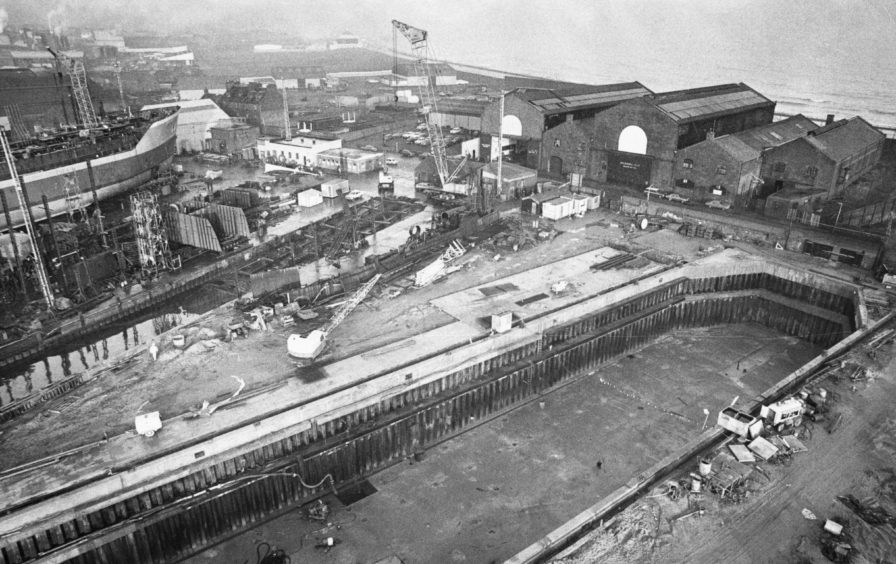Stan Bruce vividly remembers standing on the bow of a ship “up in the heavens” waiting for it to be launched.
The former shipbuilder can recall the sound of the axes chapping at the ropes and the banging of hammers knocking the supporting planks out of the way.
And then, the feeling of the boat hitting the water in the harbor for the first time.
“I have so many good memories,” he said, smiling fondly.
“You can’t beat the ship launches, though. Sometimes I was under the ship when they cut the triggers and sometimes I was on the bow when the ship went down.
“You’re up in the heavens really, it’s so high up it’s unbelievable. You can see everything and feel it going into the water.”
Mr Bruce started working at the Aberdeen shipyard in 1980 when he was just 16, not really knowing what direction his career would take him.
He worked at Hall Russell & Co for 10 years, learning everything he possibly could while enjoying his time – and the banter – in the yard.
And now, he writes books about shipbuilding across the north-east to keep its history alive.
‘Jack of all trades’
He originally applied to become a joiner at Hall Russell, but when they saw his O grades and highers they said he should apply to the drawing office.
From there it all “fell into place” for Mr Bruce who then started as a draftsman apprentice.
He spent the first month in the training center, learning welding, plating, and using the guillotine before learning how to draw.
By his third year, he was drawing for the ships being built in the yard.
While Mr. Bruce was working at Hall Russell he also spent time in the planning office, outfitting, steel work, and ship repairs – as well as going on sea trials.
The former shipbuilder also spent five-and-a-half years working as an assistant manager at Hall Russell.
He got his HNC in shipbuilding and then went to RGU to get a degree in mechanical engineering, which involved electrical work.
“Like a Jack of all trades, I wanted to know a bit about everything,” he said.
Sharing the story ‘needs to be done’
Hall Russell was the last of the Aberdeen shipbuilders, closing in 1992. It made iron and steel ships, ranging from cargo vessels to warships.
Mr Bruce left the trade the year before the yard closed to become a surveyor at the age of 27 – which he has been doing ever since.
While nothing is left of the original shipyards, apart from the closed Neptune Bar and the dry dock, Mr Bruce is determined to keep history alive.
So far, he has written around 700 poems – which he says are “getting better now” – and 50 books.
He was also chairman of the Banffshire Maritime Heritage Association for some time and has put up plaques and sculptures dedicated to history.
When Mr. Bruce worked at the shipyards, he would speak to Adam Leiper, the electrical manager, who collated pictures and stories from the yards.
After Mr Leiper died, he decided to take on the role of sharing the history of shipbuilding and recognizing the innovative designs that came from Aberdeen.
He said: “I don’t think anybody else is doing it, Adam said when he’s away I have to carry on.
“That was enough encouragement for me. It needs to be done, before too long we will be gone.”
Research takes him back to his shipbuilding days
Recently, he was asked to talk at an event celebrating Aberdeen shipbuilding and the success of the Thermopylae – marking the 150th anniversary of the Aberdeen ship’s success in the Great Tea Race.
Mr Bruce organized the commemorative plaque and already had one installed in York Place to recognize the Thermopylae and its win over the Cutty Sark.
He also wrote a poem to mark the unveiling of the plaque at its permanent home at Aberdeen Harbour.
Mr. Bruce says he has more volumes “well under way” and plans to continue his research even further.
He finished: “I miss my shipbuilding days, but researching Aberdeen’s shipbuilding history takes me back there. I love finding out about all the ships built in Aberdeen and what happened to them, so that’s why I do it.
“I talked about 16 of what I consider the most significant ships built in Aberdeen recently in the Aberdeen Maritime Museum, among these was of course the Thermopylae, the Scottish Maid, and the Sir William Hardy.
“Maybe we will have plaques to commemorate these one day. I’ll screw them on a wall myself if I have to, just as I did for the Thermopylae in 2018.”
The local historian’s 22 volumes on Aberdeen shipbuilding are all available online for free.
Already a subscriber? sign in
[Meet the man keeping the history of Aberdeen shipbuilding alive]
[[text]]






